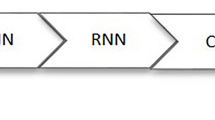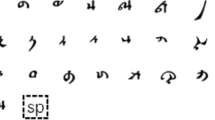Abstract
Inspired by recent successes in neural machine translation and image caption generation, we present an attention-based encoder–decoder model (AED) to recognize handwritten Vietnamese text. The model consists of two parts: a Convolutional Neural Network-based (CNN) encoder and a Long Short-Term Memory-based (LSTM) decoder. The encoder is based on DenseNet for extracting invariant features. The LSTM-based decoder with an attention model incorporated generates output text. The input of the encoder is a handwritten text image and the target of the decoder is the corresponding text of the input image. Our model is trained end-to-end to predict the text from a given input image since all the parts are differential components. In the experiment section, we evaluate our proposed AED model on the VNOnDB-Word and VNOnDB-Line datasets to verify its efficiency. The experiential results show that our model achieves 4.10% of character error eate (CER) and 10.24% of word error rate (WER) on the testing set of VNOnDB-Word and 4.67% of CER and 13.33% of WER on the testing set of VNOnDB-Line without using any language model. This result is higher than our previous system, Nguyen et al.’s system, and the system provided by Google in the Vietnamese Online Handwritten Text Recognition competition.






Similar content being viewed by others
References
Plamondon R, Srihari SN. Online and off-line handwriting recognition: a comprehensive survey. IEEE Trans Pattern Anal Mach Intell. 2000;22:63–84. https://doi.org/10.1109/34.824821.
Nakagawa M, Matsumoto K. Collection of on-line handwritten Japanese character pattern databases and their analyses. Int J Doc Anal Recognit. 2004;7:69–81. https://doi.org/10.1007/s10032-004-0125-4.
Liu CL, Jaeger S, Nakagawa M. Online recognition of Chinese characters: the state-of-the-art. IEEE Trans Pattern Anal Mach Intell. 2004;26:198–213. https://doi.org/10.1109/TPAMI.2004.1262182.
Frinken V, Fischer A, Bunke H. A novel word spotting algorithm using bidirectional long short-term memory neural networks. In: Proceedings of the 4th workshop on artificial neural networks in pattern recognition. 2010. pp. 185–196. https://doi.org/10.1007/978-3-642-12159-3_17.
Al Hamad HA, Abu Zitar R. Development of an efficient neural-based segmentation technique for Arabic handwriting recognition. Pattern Recognit. 2010;43:2773–98. https://doi.org/10.1016/j.patcog.2010.03.005.
Graves A, Fernández S, Liwicki M, Bunke H, Schmidhuber U, Schmidhuber J, Fernández S. Unconstrained online handwriting recognition with recurrent neural networks. Adv Neural Inf Process Syst. 2008;20:577–84. https://doi.org/10.1057/9780230226203.3287.
Zhu B, Nakagawa M. Building a compact online MRF recognizer for large character set by structured dictionary representation and vector quantization technique. Pattern Recognit. 2014;47:982–93. https://doi.org/10.1016/j.patcog.2013.09.031.
Sun L, Su T, Liu C, Wang R. Deep LSTM networks for online chinese handwriting recognition. In: Proceedings of the 15th international conference on frontiers in handwriting recognition. 2016. pp. 271–276. https://doi.org/10.1109/ICFHR.2016.0059.
Zhang X-Y, Bengio Y, Liu C-L. Online and offline handwritten Chinese character recognition: a comprehensive study and new benchmark. Pattern Recognit. 2016;61:348–60. https://doi.org/10.1016/j.patcog.2016.08.005.
Biadsy F, Saabni R, El-Sana J. Segmentation-free online arabic handwriting recognition. Int J Pattern Recognit Artif Intell. 2011;25:1009–33. https://doi.org/10.1142/S0218001411008956.
Álvaro F, Sánchez JA, Benedí JM. Recognition of on-line handwritten mathematical expressions using 2D stochastic context-free grammars and hidden Markov models. Pattern Recognit Lett. 2014;35:58–67. https://doi.org/10.1016/j.patrec.2012.09.023.
Le AD, Nakagawa M. A system for recognizing online handwritten mathematical expressions by using improved structural analysis. Int J Doc Anal Recognit. 2016;19:305–19. https://doi.org/10.1007/s10032-016-0272-4.
Nguyen DK, Bui TD. On the problem of classifying vietnamese online handwritten characters. In: Proceedings of the 10th international conference on control, automation, robotics and vision. 2008. pp. 803–808. https://doi.org/10.1109/ICARCV.2008.4795620.
Nguyen DK, Bui TD. Recognizing Vietnamese online handwritten separated characters. In: Proceedings of the 7th international conference on advanced language processing and web information technology. 2008. pp. 279–284. https://doi.org/10.1109/ALPIT.2008.58.
Phuong PA, Tao NQ, Mai LC: An efficient model for isolated Vietnamese handwritten recognition. In: Proceedings of the international conference on intelligent information hiding and multimedia signal processing. 2008. pp. 358–361. https://doi.org/10.1109/IIH-MSP.2008.67.
Tran DC. An efficient method for on-line Vietnamese handwritten character recognition. In: Proceedings of the 3rd symposium on information and communication technology. 2012. pp. 135–141. https://doi.org/10.1145/2350716.2350737.
Nguyen HT, Nguyen CT, Bao PT, Nakagawa M. A database of unconstrained Vietnamese online handwriting and recognition experiments by recurrent neural networks. Pattern Recognit. 2018;78:291–306. https://doi.org/10.1016/j.patcog.2018.01.013.
Guyon I, Schomaker L. UNIPEN project of on-line data exchange and recognizer benchmarks. In: Proceedings of the 12th IAPR international conference on pattern recognition. 1994. pp. 29–33. https://doi.org/10.1109/ICPR.1994.576870.
Viard-Gaudin C, Lallican PM, Knerr S, Binter P. The IRESTE on/off (IRONOFF) dual handwriting database. In: Proceedings of the 5th international conference on document analysis and recognition. 1999. pp. 455–458. https://doi.org/10.1109/ICDAR.1999.791823.
Nguyen HT, Nguyen CT, Nakagawa M. ICFHR 2018—competition on Vietnamese online handwritten text recognition using HANDS-VNOnDB (VOHTR2018). In: Proceedings of the 18th international conference on frontiers in handwriting recognition. 2018. pp. 494–499. https://doi.org/10.1109/ICFHR-2018.2018.00092.
Le AD, Nguyen HT, Nakagawa M. Recognizing unconstrained Vietnamese handwriting by attention based encoder decoder model. In: Proceedings of the 12th international conference on advanced computing and applications. 2018. pp. 83–87. https://doi.org/10.1109/ACOMP.2018.00021.
Huang G, Liu Z, Van Der Maaten L, Weinberger KQ. Densely connected convolutional networks. In: Proceedings of the 30th IEEE conference on computer vision and pattern recognition. 2017. pp. 2261–2269. https://doi.org/10.1109/CVPR.2017.243.
Le AD, Nakagawa M. Training an end-to-end system for handwritten mathematical expression recognition by generated patterns. In: Proceedings of the 14th IAPR international conference on document analysis and recognition. 2017. pp. 1056–1061. https://doi.org/10.1109/ICDAR.2017.175.
Deng Y, Kanervisto A, Ling J, Rush AM. Image-to-markup generation with coarse-to-fine attention. In: Proceedings of the 34th international conference on machine learning. 2016. pp. 980–989. https://doi.org/10.2340/16501977-0511.
Zhang J, Du J, Dai L. Multi-scale attention with dense encoder for handwritten mathematical expression recognition. In: Proceedings of the 24th international conference on pattern recognition. 2018. pp. 2245–2250. https://doi.org/10.1109/ICPR.2018.8546031.
Thi LN, My LH, Viet NH, Minh NTH, Hong LP. Building a treebank for Vietnamese dependency parsing. In: Proceedings of the international conference on computing and communication technologies: research, innovation, and vision for future. 2013. pp. 147–151. https://doi.org/10.1109/RIVF.2013.6719884.
Author information
Authors and Affiliations
Corresponding author
Ethics declarations
Conflict of Interest
The authors declare that they have no conflict of interest.
Additional information
Publisher's Note
Springer Nature remains neutral with regard to jurisdictional claims in published maps and institutional affiliations.
This article is part of the topical collection “Future Data and Security Engineering” guest edited by Tran Khanh Dang.
Rights and permissions
About this article
Cite this article
Le, A.D., Nguyen, H.T. & Nakagawa, M. An End-to-End Recognition System for Unconstrained Vietnamese Handwriting. SN COMPUT. SCI. 1, 7 (2020). https://doi.org/10.1007/s42979-019-0001-4
Received:
Accepted:
Published:
DOI: https://doi.org/10.1007/s42979-019-0001-4




